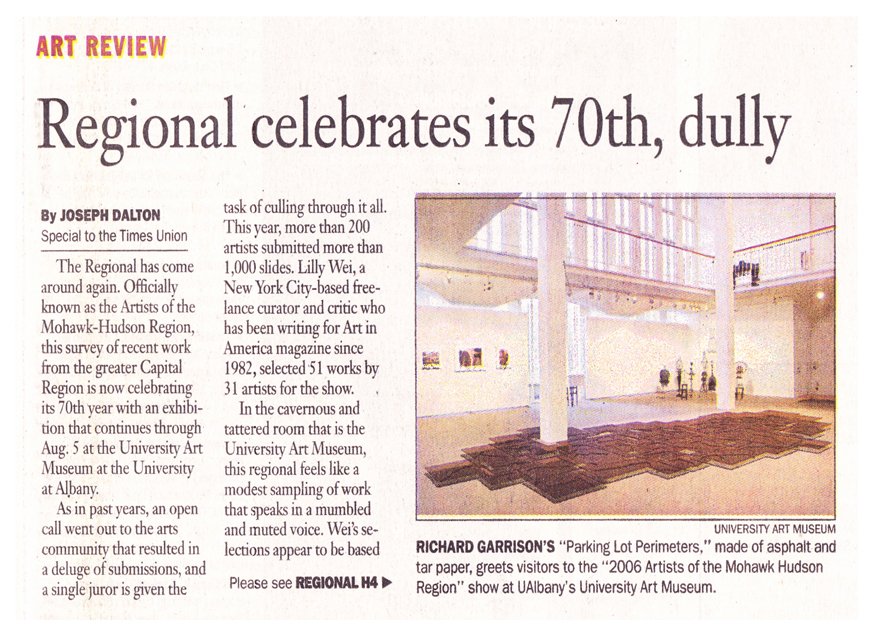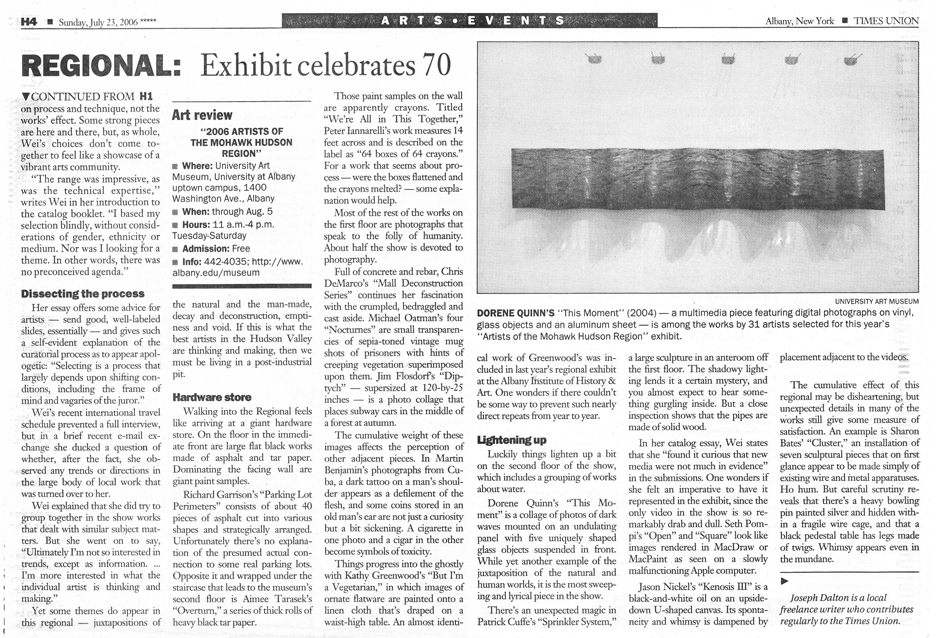
Photo Caption: RICHARD GARRISON'S "Parking Lot Perimeters," made of asphalt and tar paper, greets visitors to the "2006 Artists of the Mohawk Hudson Region" show at UAlbany's University Art Museum.
Regional celebrates its 70th, dully
Section: Arts-Events, Page: H1
Date: Sunday, July 23, 2006
The Regional has come around again. Officially known as the Artists of the Mohawk-Hudson Region, this survey of recent work from the greater Capital Region is now celebrating its 70th year with an exhibition that continues through Aug. 5 at the University Art Museum at the University at Albany.
As in past years, an open call went out to the arts community that resulted in a deluge of submissions, and a single juror is given the task of culling through it all. This year, more than 200 artists submitted more than 1,000 slides. Lilly Wei, a New York City-based freelance curator and critic who has been writing for Art in America magazine since 1982, selected 51 works by 31 artists for the show. In the cavernous and tattered room that is the University Art Museum, this regional feels like a modest sampling of work that speaks in a mumbled and muted voice. Wei's selections appear to be based on process and technique, not the works' effect. Some strong pieces are here and there, but, as whole, Wei's choices don't come together to feel like a showcase of a vibrant arts community.
"The range was impressive, as was the technical expertise," writes Wei in her introduction to the catalog booklet. "I based my selection blindly, without considerations of gender, ethnicity or medium. Nor was I looking for a theme. In other words, there was no preconceived agenda."

Photo Caption: DORENE QUINN'S "This Moment" (2004) - a multimedia piece featuring digital photographs on vinyl, glass objects and an aluminum sheet - is among the works by 31 artists selected for this year's "Artists of the Mohawk Hudson Region" exhibit.
Dissecting the process
Her essay offers some advice for artists send good, well-labeled slides, essentially and gives such a self-evident explanation of the curatorial process as to appear apologetic: "Selecting is a process that largely depends upon shifting conditions, including the frame of mind and vagaries of the juror."
Wei's recent international travel schedule prevented a full interview, but in a brief recent e-mail exchange she ducked a question of whether, after the fact, she observed any trends or directions in the large body of local work that was turned over to her.
Wei explained that she did try to group together in the show works that dealt with similar subject matters. But she went on to say, "Ultimately I'm not so interested in trends, except as information. ... I'm more interested in what the individual artist is thinking and making."
Yet some themes do appear in this regional juxtapositions of the natural and the man-made, decay and deconstruction, emptiness and void. If this is what the best artists in the Hudson Valley are thinking and making, then we must be living in a post-industrial pit.
Hardware store
Walking into the Regional feels like arriving at a giant hardware store. On the floor in the immediate front are large flat black works made of asphalt and tar paper. Dominating the facing wall are giant paint samples.
Richard Garrison's "Parking Lot Perimeters" consists of about 40 pieces of asphalt cut into various shapes and strategically arranged. Unfortunately there's no explanation of the presumed actual connection to some real parking lots. Opposite it and wrapped under the staircase that leads to the museum's second floor is Aimee Tarasek's "Overturn," a series of thick rolls of heavy black tar paper.
Those paint samples on the wall are apparently crayons. Titled "We're All in This Together," Peter Iannarelli's work measures 14 feet across and is described on the label as "64 boxes of 64 crayons." For a work that seems about process were the boxes flattened and the crayons melted? some explanation would help.
Most of the rest of the works on the first floor are photographs that speak to the folly of humanity. About half the show is devoted to photography.
Full of concrete and rebar, Chris DeMarco's "Mall Deconstruction Series" continues her fascination with the crumpled, bedraggled and cast aside. Michael Oatman's four "Nocturnes" are small transparencies of sepia-toned vintage mug shots of prisoners with hints of creeping vegetation superimposed upon them. Jim Flosdorf's "Diptych" supersized at 120-by-25 inches is a photo collage that places subway cars in the middle of a forest at autumn.
The cumulative weight of these images affects the perception of other adjacent pieces. In Martin Benjamin's photographs from Cuba, a dark tattoo on a man's shoulder appears as a defilement of the flesh, and some coins stored in an old man's ear are not just a curiosity but a bit sickening. A cigarette in one photo and a cigar in the other become symbols of toxicity.
Things progress into the ghostly with Kathy Greenwood's "But I'm a Vegetarian," in which images of ornate flatware are painted onto a linen cloth that's draped on a waist-high table. An almost identical work of Greenwood's was included in last year's regional exhibit at the Albany Institute of History & Art. One wonders if there couldn't be some way to prevent such nearly direct repeats from year to year.
Lightening up
Luckily things lighten up a bit on the second floor of the show, which includes a grouping of works about water.
Dorene Quinn's "This Moment" is a collage of photos of dark waves mounted on an undulating panel with five uniquely shaped glass objects suspended in front. While yet another example of the juxtaposition of the natural and human worlds, it is the most sweeping and lyrical piece in the show.
There's an unexpected magic in Patrick Cuffe's "Sprinkler System," a large sculpture in an anteroom off the first floor. The shadowy lighting lends it a certain mystery, and you almost expect to hear something gurgling inside. But a close inspection shows that the pipes are made of solid wood.
In her catalog essay, Wei states that she "found it curious that new media were not much in evidence" in the submissions. One wonders if she felt an imperative to have it represented in the exhibit, since the only video in the show is so remarkably drab and dull. Seth Pompi's "Open" and "Square" look like images rendered in MacDraw or MacPaint as seen on a slowly malfunctioning Apple computer.
Jason Nickel's "Kenosis III" is a black-and-white oil on an upside-down U-shaped canvas. Its spontaneity and whimsy is dampened by placement adjacent to the videos.
The cumulative effect of this regional may be disheartening, but unexpected details in many of the works still give some measure of satisfaction. An example is Sharon Bates' "Cluster," an installation of seven sculptural pieces that on first glance appear to be made simply of existing wire and metal apparatuses. Ho hum. But careful scrutiny reveals that there's a heavy bowling pin painted silver and hidden within a fragile wire cage, and that a black pedestal table has legs made of twigs. Whimsy appears even in the mundane.
Joseph Dalton is a local freelance writer who contributes regularly to the Times Union.
****FACT BOX:****
"2006 ARTISTS OF THE MOHAWK HUDSON REGION"
Where: University Art Museum, University at Albany uptown campus, 1400 Washington Ave., Albany
When: through Aug. 5
Hours: 11 a.m.-4 p.m. Tuesday-Saturday
Admission: Free
Info: 442-4035; http://www. albany.edu/museum